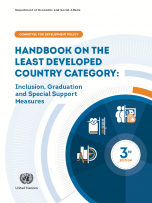
New handbook guides least developed countries
Around the world today, 47 nations – representing some 986 million people – are identified as the most disadvantaged developing countries, so called least developed countries (LDCs). Thanks to progress in economic growth and human development over the past decades, more and more LDCs are making advancements towards graduating from the LDC category. But how countries are added and removed from the LDC category and what benefits they receive often remains unknown.
According to Roland Mollerus, Secretary of the United Nations Committee for Development Policy (CDP) in UN DESA, “improved information on the LDC category will enable countries to make better use of international support measures and prepare them better for an eventual graduation”.
 The third edition of the Handbook on the Least Developed Country Category: Inclusion, Graduation and Special Support Measures, launched at UN Headquarters on 27 November 2018, demystifies the LDC category and provides clear explanations on LDC processes and support measures.
The third edition of the Handbook on the Least Developed Country Category: Inclusion, Graduation and Special Support Measures, launched at UN Headquarters on 27 November 2018, demystifies the LDC category and provides clear explanations on LDC processes and support measures.
“The process of identifying LDCs can be complex, but it is based on a thorough methodology that avoids ‘one-size-fits-all’ fallacies and minimizes the risk that countries are falling back into the LDC category,” said Matthias Bruckner, Economic Affairs Officer from the CDP Secretariat.
The Handbook explains in detail the different steps of inclusion and graduation from the LDC list. It explains data sources and methodologies for the three LDC criteria developed by the CDP (gross national income per capita, a human asset index, and an economic vulnerability index).
It uses the results of the most recent triennial review of 2018 as basis for visual illustrations, showing for example why Kiribati is the most vulnerable among the LDCs while also having the third highest score of the human asset index.
The Handbook also provides an overview of the support measures to which LDCs are entitled, including the possibility to export goods to most developed and many developing countries on a duty-free, quota-free basis and exclusive access to a few exclusive multilateral support mechanisms. Special attention is given to “smooth transition” provisions for countries graduating from the LDC category.
As a tool to better understand the LDC category and the challenges confronting the LDCs, the Handbook can be valuable to galvanize support for those countries most at risk of being left behind. The Handbook can be accessed online here.

Follow Us